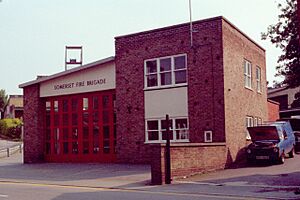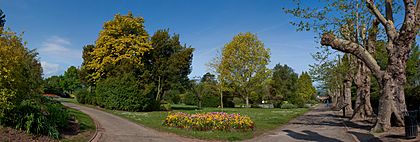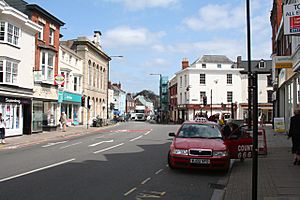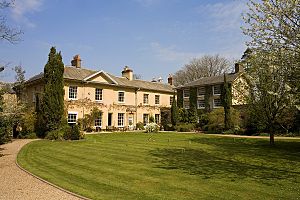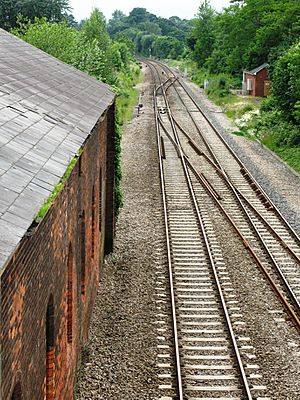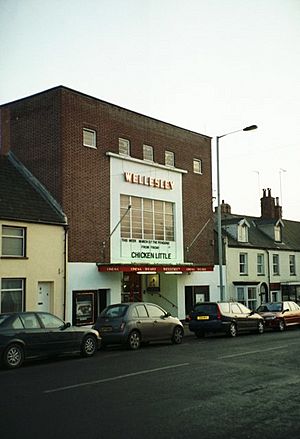Wellington, Somerset facts for kids
Quick facts for kids Wellington |
|
|---|---|
 Wellington from Chelmsine |
|
| Population | 16,669 (2021 Census) |
| OS grid reference | ST140203 |
| Civil parish |
|
| Unitary authority |
|
| Ceremonial county | |
| Region | |
| Country | England |
| Sovereign state | United Kingdom |
| Post town | WELLINGTON |
| Postcode district | TA21 |
| Dialling code | 01823 |
| Police | Avon and Somerset |
| Fire | Devon and Somerset |
| Ambulance | South Western |
| EU Parliament | South West England |
| UK Parliament |
|
Wellington is a market town in Somerset, England. It's about 7 miles (11 km) southwest of Taunton. It's also close to the border with Devon, near the Blackdown Hills. In 2021, about 16,669 people lived here. This number includes people from nearby villages like Tone and Tonedale.
Long ago, during the Anglo-Saxon times, it was called Weolingtun. By 1086, when the Domesday Book was written, its name had changed to Walintone. Wellington became a town with a special royal paper in 1215. During the Middle Ages, it grew into an important trading spot on the road from Bristol to Exeter.
A big fire happened in the town in 1731, leading to major rebuilding. After this, Wellington became a key place for making cloth.
In 1809, the town's name was used for a special title. This title was given to Arthur Wellesley after he won the Battle of Talavera. He later became the famous Duke of Wellington. The Wellington Monument south of the town remembers him.
The Grand Western Canal reached Wellington in 1835. Then, the Bristol and Exeter Railway arrived in 1843. The town's own railway station stayed open until 1964. Wellington was also home to Fox, Fowler and Company. This was the last private bank in England and Wales allowed to print its own money notes.
Today, local businesses include an aerosol factory and Relyon, which makes beds. You can learn about these industries at the Wellington Museum. Wellington also has the private Wellington School and the public Court Fields School. It's home to many cultural, sports, and religious places, like the 15th-century Church of St John the Baptist.
The capital city of New Zealand, also called Wellington, is named after Arthur Wellesley, 1st Duke of Wellington. So, the New Zealand capital gets its name from this English town in Somerset.
Contents
History of Wellington

The name Weolingtun means "wealthy estate." Around 899 to 909, Edward the Elder gave this land to Bishop Asser. This was in exchange for a monastery in Devon. Another idea is that the name means "the settlement in the temple clearing." By 1086, the name was Walintone, and Gisa (Bishop of Wells) owned the land.
Near Tonedale, old remains show that people lived there during the Bronze Age. Later, a building from the 12th to 14th century was found there.
In 1215, Wellington officially became a town. During the medieval period, it grew as a trading center. It was located on the main road from Bristol to Exeter.
A major fire in 1731 led to a lot of rebuilding in Wellington. After this, the town became very important for making cloth in Somerset and Devon. By 1831, 258 people in Wellington worked with cloth.
Arthur Wellesley got his title, Marquess of Wellington, from this town in 1809. The Wellington Monument is a tall, triangular tower built to celebrate his victory at the Battle of Waterloo. It is 175 feet (53 meters) high. The first stone was laid in 1817, but it wasn't finished until 1854 because of money problems. The National Trust now owns it. Wellington Town Hall, which was first a market hall, was finished in 1833.
In the 18th century, better roads came to the area. Then, in the 19th century, travel improved even more. The Grand Western Canal reached the town in 1835. Wellington railway station opened in 1843. It closed on October 5, 1964.
In the 20th century, many people from Wellington started working in nearby Taunton. The M5 motorway, which opened in the 1960s and 1970s, made car travel much easier.
Fox Fowler & Co. Bank
Thomas Fox started the Fox, Fowler and Company bank in Wellington. It grew quickly and did very well. In 1927, it joined with Lloyds Bank. It was the last private bank in England to print its own money notes. These notes were legal to use until 1964. Today, only nine of these notes are still known to exist. The British Museum has one on display. The bank had its main office in Wellington and opened branches in other towns like Taunton and Bridgwater.
Town Governance
Wellington has two levels of local government. The first is the Wellington Town Council. It has 15 councillors and is led by a town mayor. The town is divided into four areas for elections: Wellington East, Wellington North, Rockwell Green, and Wellington West. The Town Council handles local services for the town.
The second level is Somerset Council. This council is based in Taunton. It has 110 councillors who are elected from different areas. Somerset Council is in charge of bigger services. These include education, social services, libraries, roads, and public transport. Fire, police, and ambulance services are shared with other areas.
For national elections, Wellington is part of the Taunton and Wellington area. This area elects one Member of Parliament (MP) to the House of Commons.
Geography and Nature
Wellington has many nearby villages, like West Buckland and Nynehead. The village of Rockwell Green is now part of the town. Wellington Park was given to the town in 1903 by the Fox family. It was a gift to celebrate King Edward VII's coronation. The park's gardens are 4.9 acres (2.0 hectares) and include a rock garden. The park has been restored with help from the Heritage Lottery Fund.
There are also Local Nature Reserves in Wellington. Wellington Basins has a small pond and boardwalk. It is home to many animals and plants. You can see birds like the grey wagtail and reed bunting. Five different types of bats have been found here. Swains Pond is another nature reserve. It used to be an orchard. Now, it has a pond where amphibians like the great crested newt and toads live.
Weather in Wellington
Wellington has a mild and wet climate. The average yearly temperature is about 10°C (50°F). Summers are warmest in July and August, with highs around 21°C (70°F). In winter, the lowest temperatures are usually 1°C (34°F) or 2°C (36°F).
The area gets about 700 mm (28 inches) of rain each year. Most of the rain in autumn and winter comes from storms from the Atlantic Ocean. In summer, rain often comes from showers and thunderstorms. Snowfall usually happens 8 to 15 days a year. Winds are strongest from November to March, usually from the southwest.
Economy and Industry
Wellington's main industry used to be making wool. In 2009, Deborah Meaden from the TV show Dragons' Den invested in the Fox Brothers' Mill. This mill, started by the Fox family in 1772, still makes wool cloth today. The Tonedale mill complex has old buildings, some of which were used until 2000. Efforts are being made to save and reuse these historic buildings.
The last Fox family house in Wellington, Tone Dale House, is still owned by the Fox family. It is now used for events like parties and weddings.
You can learn about local industries at the Wellington Museum. Wellington was home to Fox, Fowler and Company, the last private bank in England to print its own money notes.
The town still relies on industry. Manufacturing is important here because of good transport links. Swallowfield plc makes aerosol, cosmetic, and toiletry products. It started in 1876. Relyon, a company that makes beds, employs about 400 people. It began in 1858 as a wool merchant.
Transport Links
Wellington used to have its own railway station from 1843 to 1964. Trains still pass through the town on their way to London and Bristol, but they don't stop. The closest train stations are Taunton and Tiverton Parkway. There was a plan to reopen the station, which was approved in 2023, but funding was removed in 2024.
The town is near junction 26 of the M5 motorway. The A38 road is also an important link to Taunton. Wellington also has a bus service to and from London.
Education in Wellington
Wellington is home to Wellington School, a private school. It started in 1837 as a school for boys. In 1973, it became a school for both boys and girls. Famous people who went to Wellington School include actor David Suchet and chef Keith Floyd.
The main secondary school in the town is Court Fields School. This school is for students aged 11 to 16. It has a sports complex that was finished in 2008.
Places of Worship
Wellington has many different churches. These include a Quaker meeting house and the 15th-century Church of St John the Baptist. This church is a very old and important building. The Roman Catholic Church of St John Fisher was built in 1606 and became a church in 1936.
Culture and Arts
Wellington has its own amateur drama group, the Wellington Arts Association. They put on plays at the Wellington Arts Centre and the Wellesley Theatre. This group includes youth theatre, an opera group, and a pantomime group. The Wellesley Cinema was built in 1937 in the Art Deco style. It's an independent cinema with 400 seats.
The Wellington and District Camera Club meets at Wellington School. The town also has its own weekly newspaper, the Wellington Weekly News, which started in 1860. There's also a community website called Around Wellington.
Wellington is home to the Wellington Silver Band, a brass band that started in 1887.
Wellington is twinned with towns in other countries. These are Immenstadt in Germany, Lillebonne in France, and Torres Vedras in Portugal.
Sports in Wellington
Wellington Cricket Club has two teams that play in the Somerset Cricket League. Wellington A.F.C. football Club started in 1892 and plays in the Western Football League.
Wellington Bowmen is an archery club that started in 2001. The Rugby club was founded in 1874. Its first team plays in the Western Counties West League.
The horse Miinnehoma, which won the 1994 Grand National race, was trained in Wellington by Martin Pipe.
Freedom of the Town
The town of Wellington has given special honors to certain people and military groups. This honor is called the "Freedom of the Town."
Individuals
- Richard Fox: 2011.
Military units
- The Rifles: 17 June 2023.
Images for kids
See also
 In Spanish: Wellington (Somerset) para niños
In Spanish: Wellington (Somerset) para niños





